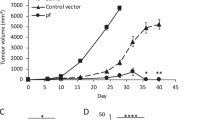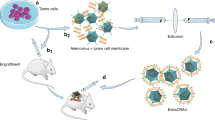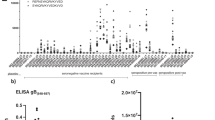Abstract
The life span of C57/Bl mice inoculated with Lewis lung carcinoma cells was prolonged if the mice were pre-immunized with membranes from these cells infected in vitro with influenza virus. Likewise, BALB/c mice were protected against the malignant tumour WEHI-11 by prior immunization with extracts of cultured WEHI-11 cells which had been infected with influenza virus or Semiliki Forest virus (SFV). Partially purified SFV grown in WEHI-11 cells also protected mice from cancer grafts but neither highly purified SFV nor the glycoprotein from the envelope of this virus protected the mice. It is concluded that SFV-induced immunopotentiation against cancer is not due to covalent linkage of tumour specific transplantation antigen (TSTA) to viral envelope protein but more probably is due to the apposition of viral glycoprotein and cellular TSTA in the plasma membrane of the cancer cell.
This is a preview of subscription content, access via your institution
Access options
Subscribe to this journal
Receive 24 print issues and online access
$259.00 per year
only $10.79 per issue
Buy this article
- Purchase on Springer Link
- Instant access to full article PDF
Prices may be subject to local taxes which are calculated during checkout
Similar content being viewed by others
Rights and permissions
About this article
Cite this article
Griffith, I., Crook, N. & White, D. Protection of mice against cancer by immunization with membranes but not purified virions from virus infected cancer cells. Br J Cancer 31, 603–613 (1975). https://doi.org/10.1038/bjc.1975.106
Issue Date:
DOI: https://doi.org/10.1038/bjc.1975.106
This article is cited by
-
Growth, purification and characterization of Semliki Forest Virus in Ehrlich Ascites tumor cell suspensions
Archives of Virology (1976)



